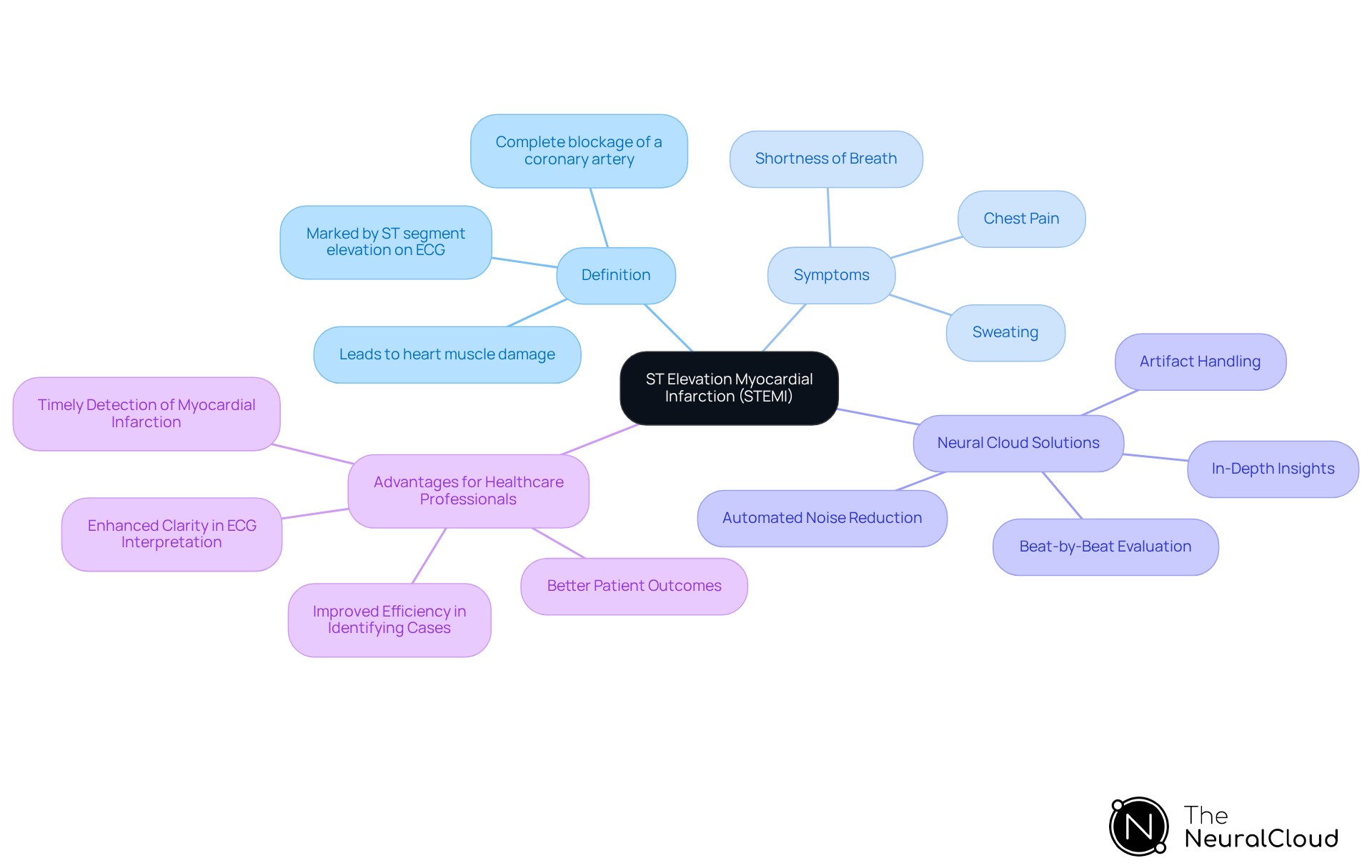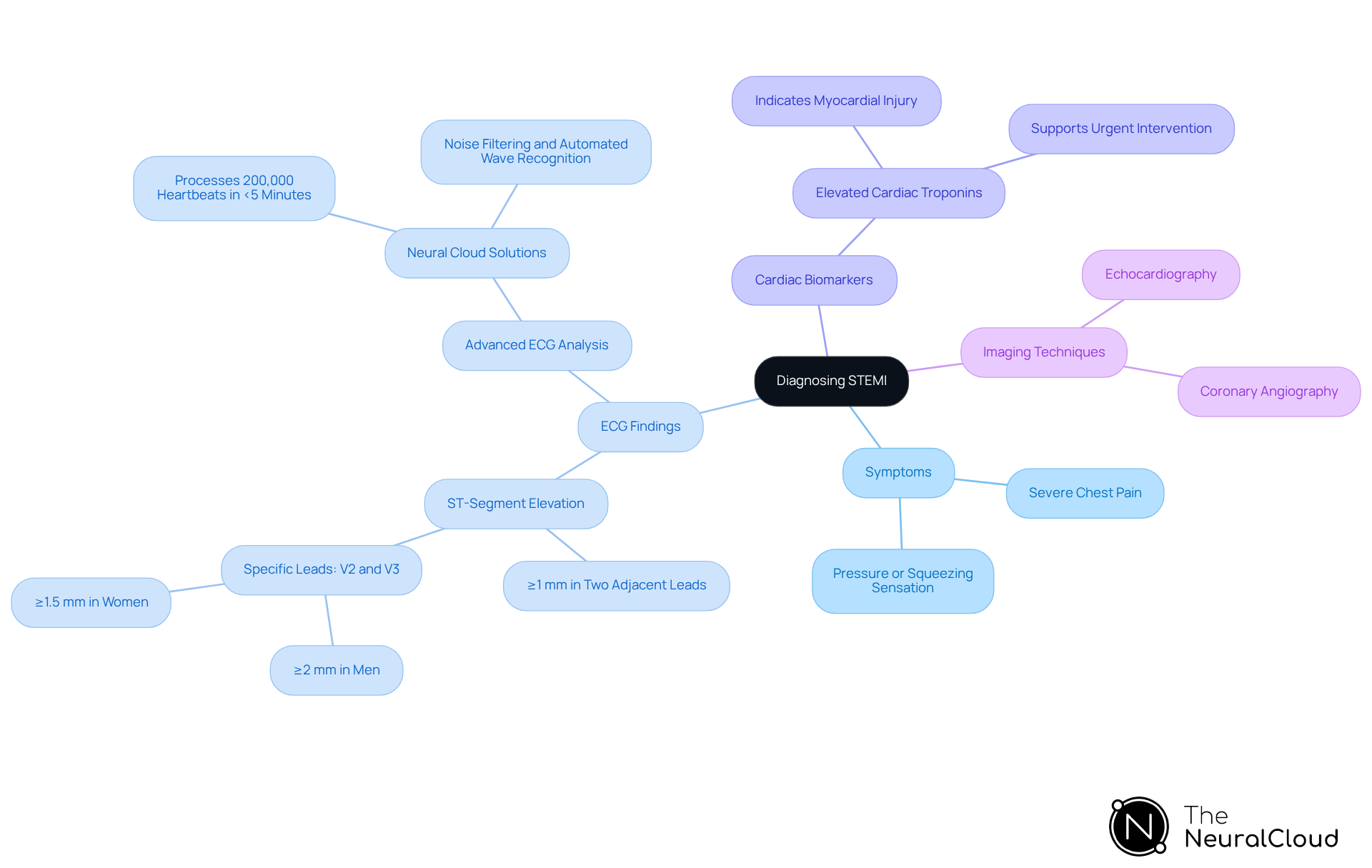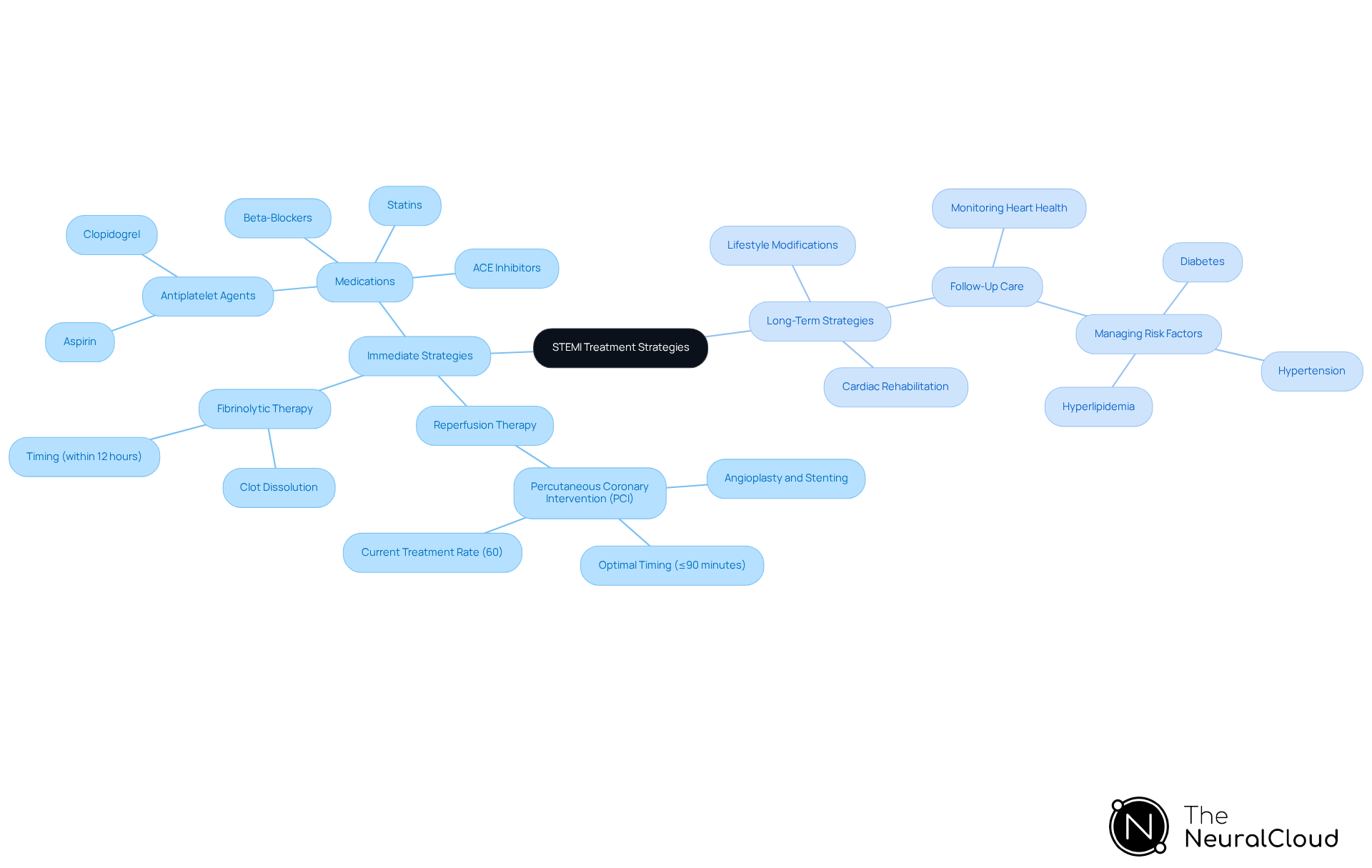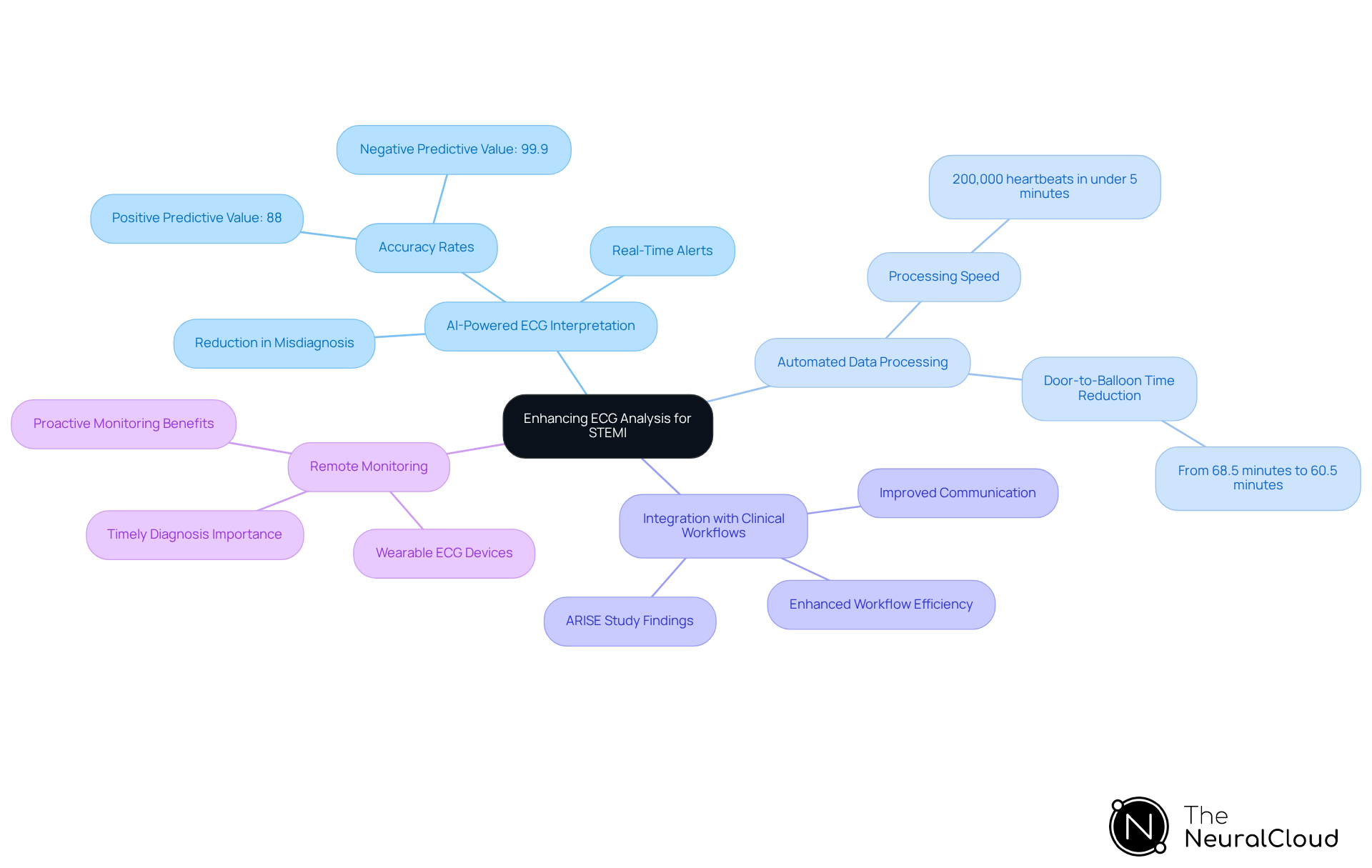Overview
The article provides an overview of the challenges associated with ECG analysis, particularly in the context of diagnosing and treating ST elevation myocardial infarction (STEMI). It emphasizes the critical need for timely intervention to enhance patient outcomes. Advanced ECG analysis technologies, such as Neural Cloud Solutions' MaxYield™, are highlighted for their role in improving diagnostic accuracy and efficiency.
MaxYield™ offers several key features:
- Enhanced data processing
- Real-time analysis
- User-friendly interfaces
These features allow healthcare professionals to interpret ECG data more effectively, reducing the time required for diagnosis. As a result, the platform facilitates quicker and more effective treatment strategies for this life-threatening condition.
The advantages of using MaxYield™ extend beyond mere efficiency. By improving diagnostic accuracy, the platform ultimately leads to better patient outcomes, as timely interventions are crucial in managing STEMI cases. This educational approach ensures that both technical and non-technical readers can appreciate the importance of advanced ECG analysis technologies in modern healthcare.
Introduction
ST Elevation Myocardial Infarction (STEMI) is a critical medical emergency that requires immediate attention and intervention. In the U.S., there are over a million cases of acute coronary syndrome each year, making it essential for healthcare professionals to understand the nuances of STEMI diagnosis and treatment to improve patient outcomes. The challenge lies not only in recognizing the symptoms but also in navigating the complexities of advanced diagnostic tools and timely therapeutic strategies. How can modern technology and innovative approaches enhance the speed and accuracy of STEMI care, ultimately saving lives?
Define ST Elevation Myocardial Infarction (STEMI)
ST elevation myocardial infarction represents a severe type of heart attack caused by a complete blockage of a coronary artery, which can potentially lead to considerable damage to the heart muscle. This condition is marked by an elevation of the ST segment on an electrocardiogram (ECG), which signals transmural ischemia. Timely identification of ST elevation myocardial infarction is essential, as prompt intervention can significantly reduce morbidity and mortality rates associated with these incidents. Common symptoms include intense chest pain, shortness of breath, and sweating, all of which necessitate immediate medical attention. With over one million cases of (ACS) requiring hospitalization in the U.S. each year, the ability to quickly recognize ST elevation myocardial infarction through ECG analysis is vital for improving patient outcomes and ensuring effective treatment.
The Neural Cloud Solutions platform is instrumental in this process, enabling rapid identification of heart attack cases through advanced ECG analysis. Key features of the platform include automated noise reduction and artifact handling, which enhance clarity and efficiency in ECG interpretation. Additionally, MaxYield™ provides beat-by-beat evaluation and comprehensive insights, ensuring that critical cardiac events such as ST elevation myocardial infarction are detected swiftly and accurately.
Features of MaxYield™:
- Automated noise reduction
- Artifact handling capabilities
- Beat-by-beat evaluation
- In-depth cardiac insights
Advantages for Healthcare Professionals:
- Enhanced clarity in ECG interpretation
- Improved efficiency in identifying heart attack cases
- Timely detection of myocardial infarction
- Better patient outcomes through rapid intervention
By leveraging these capabilities, healthcare professionals can significantly enhance their diagnostic accuracy and response times, ultimately leading to improved patient care.

Diagnose STEMI: Key Criteria and Methods
Diagnosing st elevation myocardial infarction requires a thorough strategy that integrates clinical assessment with diagnostic examinations. Key criteria for diagnosis include:
- Symptoms: Patients typically present with severe chest pain, often described as a feeling of pressure or squeezing, which serves as a critical indicator of potential myocardial infarction.
- ECG Findings: The hallmark of an ST elevation myocardial infarction is ST-segment elevation of at least 1 mm in two adjacent leads on a 12-lead ECG. Specific leads, particularly V2 and V3, are crucial; elevations of 2 mm in men and 1.5 mm in women are particularly indicative of st elevation myocardial infarction. Utilizing , such as Neural Cloud Solutions' offerings, can significantly enhance the accuracy of these findings. The system processes 200,000 heartbeats in under 5 minutes, employing advanced noise filtering and automated wave recognition to convert noisy recordings into clear insights, enabling swift identification of essential ECG features, such as P-wave, QRS complex, and T-wave onsets and offsets.
- Cardiac Biomarkers: Elevated levels of cardiac troponins in blood tests further support the diagnosis of ST elevation myocardial infarction, indicating myocardial injury and the necessity for urgent intervention.
- Imaging: Additional imaging techniques, such as echocardiography or coronary angiography, may be employed to assess the extent of damage and identify occluded arteries.
Integrating MaxYield™ into the diagnostic process allows healthcare professionals to leverage AI-driven automation to streamline workflows and enhance clinical decision-making. This ultimately leads to quicker and more accurate diagnoses in emergency settings. The integration exemplifies gold standard methodologies in noise filtering and automation, thereby enhancing the overall efficiency of ECG analysis.

Treat STEMI: Immediate and Long-Term Strategies
Prompt care for st elevation myocardial infarction is essential for restoring blood flow to the heart muscle. Key strategies include:
- Reperfusion Therapy: The cornerstone of STEMI treatment is percutaneous coronary intervention (PCI), which involves angioplasty and stenting to open blocked arteries. Ideally, this procedure should be performed within 90 minutes of first medical contact to optimize outcomes. However, data indicates that only about 60% of individuals at PCI-capable centers receive treatment within this critical timeframe, highlighting a significant gap in timely care.
- Fibrinolytic Therapy: In cases where PCI is not available, fibrinolytics can be administered to dissolve the clot obstructing blood flow. This therapy is most effective when given within the first 12 hours of symptom onset, underscoring the importance of rapid intervention.
- Medications: Alongside reperfusion strategies, individuals should receive antiplatelet agents (such as aspirin and clopidogrel), beta-blockers, ACE inhibitors, and statins. These medications help manage symptoms and reduce the risk of future cardiovascular events.
Long-term management strategies are equally important and include lifestyle modifications, cardiac rehabilitation, and regular follow-up appointments to monitor heart health and manage risk factors like hypertension, diabetes, and hyperlipidemia. Ongoing progress in technology, like that offered by Neural Cloud Solutions via the MaxYield™ platform, improves the capacity to oversee and handle individuals effectively after STEMI, ensuring better results and enhanced quality of care.
Recent studies highlight that prompt treatment is connected to improved outcomes for individuals, with related to higher in-hospital mortality rates. For instance, the odds of in-hospital mortality for individuals not treated within 90 minutes at PCI-capable centers are significantly higher, reinforcing the need for coordinated strategies to improve treatment benchmarks. As healthcare systems aim for excellence in heart attack care, the incorporation of innovative solutions like the MaxYield™ platform, which automates the labeling of critical ECG waveforms and processes data efficiently, will play a vital role in closing existing gaps and improving patient outcomes.

Leverage Technology: Enhancing ECG Analysis for STEMI
Utilizing technology in is crucial for enhancing the diagnosis and management of st elevation myocardial infarction. The challenges in ECG analysis, including misdiagnosis and delayed intervention, necessitate advancements in this field. Key advancements include AI-powered ECG interpretation, automated data processing, integration with clinical workflows, and remote monitoring.
- AI-Powered ECG Interpretation: AI algorithms significantly enhance the accuracy of detecting st elevation myocardial infarction on ECGs, thereby reducing misdiagnosis rates. These systems analyze complex ECG patterns and provide real-time alerts to clinicians, ensuring timely intervention. For instance, the implementation of AI-enabled ECG systems has shown a positive predictive value of 88% and a negative predictive value of 99.9%, demonstrating their effectiveness in clinical settings.
- Automated Data Processing: Platforms such as Neural Cloud Solutions' MaxYield™ can process over 200,000 heartbeats in under five minutes, enabling beat-by-beat analysis and the identification of critical features like ST-segment elevation. This device-agnostic system captures ECG recordings from any 1-lead or 3-lead device with ease. The swift processing ability is essential for efficient care management, as research indicates a decrease in door-to-balloon time from 68.5 minutes to 60.5 minutes following AI implementation.
- Integration with Clinical Workflows: Advanced ECG analysis tools like MaxYield™ seamlessly integrate with existing clinical systems, facilitating improved communication among healthcare teams. This integration enhances workflow efficiency and supports better health outcomes, as highlighted by the ARISE study, which demonstrated significant improvements in treatment times and diagnostic accuracy with AI-enabled ECG systems.
- Remote Monitoring: Wearable ECG devices facilitate ongoing observation of individuals at risk for heart attacks, enabling early detection and intervention. This proactive method is essential for enhancing healthcare results, especially in emergency situations. As noted by Chin-Sheng Lin, M.D., the application of AI ECG systems significantly reduces the time from ECG to arrival at the cath lab door, underscoring the importance of timely diagnosis.
By embracing these technological advancements, particularly through Neural Cloud Solutions' MaxYield™, healthcare professionals can significantly enhance their diagnostic capabilities and provide timely, effective care for patients experiencing st elevation myocardial infarction.

Conclusion
ST elevation myocardial infarction (STEMI) represents a critical medical emergency that demands swift and accurate diagnosis and treatment to mitigate severe outcomes. Timely recognition and intervention are essential, and advanced technologies, such as the Neural Cloud Solutions platform and its MaxYield™ feature, play a crucial role in enhancing the diagnostic process for STEMI. By leveraging these tools, healthcare professionals can significantly improve patient outcomes and reduce mortality rates associated with this life-threatening condition.
Key arguments presented include the essential criteria for diagnosing STEMI, which encompass:
- Symptom recognition
- ECG findings
- The role of cardiac biomarkers
Immediate treatment strategies like:
- Reperfusion therapy
- Fibrinolytics
are discussed, alongside long-term management approaches that emphasize:
- Lifestyle changes
- Regular monitoring
The integration of AI-powered ECG analysis not only enhances diagnostic accuracy but also streamlines clinical workflows, ensuring that healthcare teams can respond promptly to this urgent medical need.
In conclusion, mastering the diagnosis and treatment of STEMI is of paramount importance. As healthcare systems evolve, embracing technological innovations will be vital in improving care pathways for patients experiencing myocardial infarction. By prioritizing rapid intervention and utilizing advanced ECG analysis tools, the medical community can work towards reducing the incidence of misdiagnosis and delays in treatment, ultimately saving lives and enhancing the quality of heart attack care.
Frequently Asked Questions
What is ST Elevation Myocardial Infarction (STEMI)?
ST elevation myocardial infarction is a severe type of heart attack caused by a complete blockage of a coronary artery, leading to potential significant damage to the heart muscle. It is identified by an elevation of the ST segment on an electrocardiogram (ECG), indicating transmural ischemia.
Why is timely identification of STEMI important?
Timely identification of STEMI is crucial because prompt intervention can significantly reduce morbidity and mortality rates associated with heart attacks.
What are the common symptoms of STEMI?
Common symptoms of STEMI include intense chest pain, shortness of breath, and sweating, all of which require immediate medical attention.
How prevalent are cases of acute coronary syndrome (ACS) in the U.S.?
There are over one million cases of acute coronary syndrome (ACS) requiring hospitalization in the U.S. each year.
How does the Neural Cloud Solutions platform assist in identifying STEMI?
The Neural Cloud Solutions platform aids in rapid identification of heart attack cases through advanced ECG analysis, featuring automated noise reduction, artifact handling, and beat-by-beat evaluation.
What are the key features of the MaxYield™ platform?
Key features of MaxYield™ include automated noise reduction, artifact handling capabilities, beat-by-beat evaluation, and in-depth cardiac insights.
What advantages does MaxYield™ offer to healthcare professionals?
MaxYield™ provides healthcare professionals with enhanced clarity in ECG interpretation, improved efficiency in identifying heart attack cases, timely detection of myocardial infarction, and better patient outcomes through rapid intervention.
How does the use of advanced ECG analysis improve patient care?
By leveraging advanced ECG analysis capabilities, healthcare professionals can significantly enhance their diagnostic accuracy and response times, ultimately leading to improved patient care.






